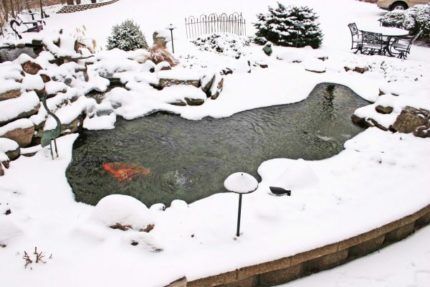How to make a pond with your own hands: instructions on creating and caring for a pond on your personal plot
Enjoying clean air and silence while sitting on the shore of your own pond is an invaluable luxury, isn’t it? Since purchasing a house near a natural lake is often too expensive, it would be a great idea to figure out how to make a pond with your own hands on your own summer cottage.
A decorative pond will transform your landscape design and bring you closer to nature. Modern technologies make it possible to equip it almost anywhere. However, in order not to harm yourself and your neighbors, before arranging a pond you need to familiarize yourself with the regulatory requirements and take into account important nuances.
We have understood the process of arranging your own pond and are ready to help organize the pond in such a way that it not only enlivens the landscape, but also maintains the correct microclimate in the garden for many years.
The content of the article:
Types of artificial reservoirs
Depending on their functional purpose and size, reservoirs are divided into the following categories.
Little pond. Its size does not imply active recreation on the shore. The main purpose of such a reservoir is to improve the territory and transform the landscape design of the garden area.
Decorative pond medium or large sizes. A deep reservoir, the dimensions of which allow the installation of bridges and curbs.
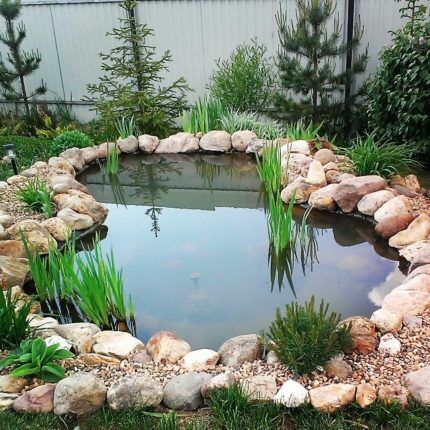
Fishing pond. Such a reservoir must be equipped with a filtration and oxygen enrichment system. The inhabitants are selected based on size and external climate: these can be both decorative individuals and fish for catching.
Choosing the location and shape of the reservoir
The shape of the pond is not regulated by any requirements. It all depends on the design and style of the summer cottage. It can be square, round or asymmetrical, the main thing is to maintain the overall concept of landscape design.
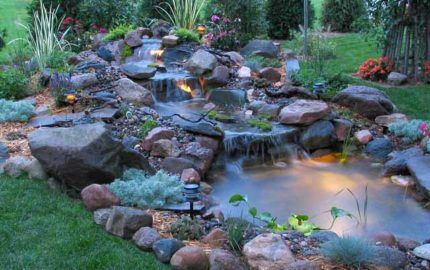
A good location is one of the key factors in the safety of an artificial reservoir. Its selection must be approached very carefully. You should first assess the terrain of the area, soil characteristics and groundwater level.
If the site has pronounced hilliness, the right solution would be to arrange a cascade type waterfall. For flat areas, it is recommended to choose small single-level ponds.
The possibility of expansion of the reservoir should be foreseen in advance. The large area of the site allows you to create additional waterfalls or fountains in the future. The size is selected based on the free area and the wishes of the owner. The golden mean is considered to be 3% of the estate area. For example, for a plot of 8 acres, the ideal size of an artificial reservoir is up to 24 m2.
It is imperative to take into account the location of trees and large shrubs relative to the planned reservoir. Before designing a pond, the approximate amount of growth of the root system of the plantings must be taken into account.
In addition, falling leaves will pollute the pond, contributing to the processes of water decay. Because of this, additional cleaning will be required. The best thing to do is to choose a place away from large vegetation.

An important aspect is lighting. A location in a shady area will slow down the growth of green spaces, and prolonged exposure to active sun will contribute to the development of mud. A well-chosen place, alternating sun and shade, will protect the pond from seasonal flowering.
Exposure to sunlight for 5-6 hours a day is considered optimal. This will be the key to maintaining the correct microclimate inside the water body.
Base options and installation instructions
The choice of base for an artificial reservoir depends, first of all, on its shape and volume. Manufacturers offer a wide selection of materials: rubber, rubber, concrete, polyethylene, PVC, fiberglass or insulating floors.
Even improvised materials are suitable for arranging a miniature pond: a bathtub left over after renovation or a large plastic container.
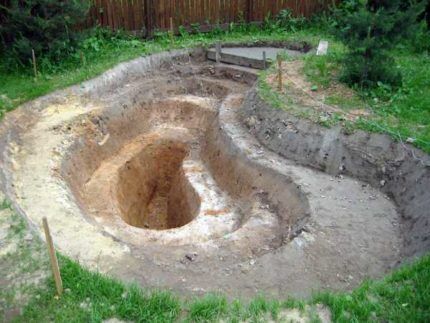
Regardless of the material chosen for the pond bowl, you will need a basic set of tools to complete the preparatory work.
It is recommended to prepare in advance:
- devices for carrying heavy loads - trolley, gloves, bucket;
- measuring instruments - tape measure, level, chalk, twine or fishing line;
- tools for preparatory work - shovel, rake;
- to work with wood and metal you will need special scissors, a saw, a jigsaw, pipe cutter;
- for working with concrete - trowel, smoother, jointing;
- construction tools - drill, screwdrivers, adjustable wrench, drill bits, hammer.
The preferred materials for the base will be discussed in detail below. Each of them has its own advantages. The choice depends on your preferences and the parameters of the future pond.
Option No. 1 - concrete base
The reliability and durability of concrete have become the key to its popularity as a basis for a pond. The advantage of the material is the ability to make a base of any shape and configuration.
The only drawback is the high cost of installing such a bowl. Concrete is most often used in swimming pools or in regions with severe temperature changes.
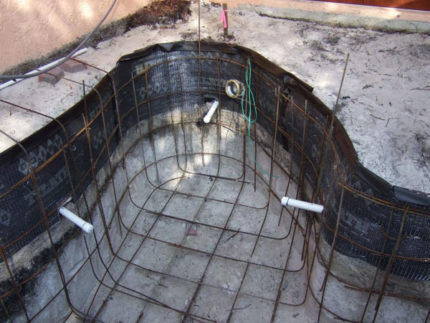
By following the technology and sequence of actions when constructing a concrete bowl, you get a reliable and durable foundation for your own pond.
Stages of arranging a concrete bowl:
- For a pond with a concrete base, it is recommended to choose a sunny area.
- First of all, you need to dig a pit and clear it of possible debris, rhizomes and stones.Depending on the size of the future reservoir, you can do this yourself or hire an excavator.
- At the next stage, it is waterproofed. To do this, you can use clay, film, or select a ready-made mold that matches the desired size of the future pond. To waterproofing material not damaged, it is recommended to make an embankment of sand up to 10 cm thick.
- After this, the first layer of concrete is applied.
- Immediately after application, reinforcement is performed - strengthening the base by immersing a metal mesh in the first layer of concrete.
- After the first layer has completely dried, the second is applied. Its thickness must be at least 5 cm.
- If the bottom is uneven, you can level it with a cement solution.
After waiting for the concrete to completely harden, you can begin to improve the pond.
Ponds with a concrete bowl are often large in size, which allows them to be decorated with tiles, natural stone, and figurines of animals or birds. The soil obtained after digging a pit can be used to create flower beds around the perimeter of the pond.
Option No. 2 - a pond from a factory mold
Another option for organizing a pond with your own hands is to purchase a ready-made plastic container. They are made of fiberglass or PVC. Service life – up to 30 years.
Its installation technology is quite simple:
- At the first stage, a pit is dug corresponding to the size of the container. It is recommended to leave gaps of up to 10 cm on each side.
- The container is immersed in the resulting pit and its sides are leveled.
- Visible edges can be masked with artificial or natural stones.
- The reservoir is filled with water.
Purchasing a ready-made base will save you from carrying out work on waterproofing. This container is inexpensive and durable.
The only drawback of a factory-made bowl for an artificial pond is the difficulty of transportation.
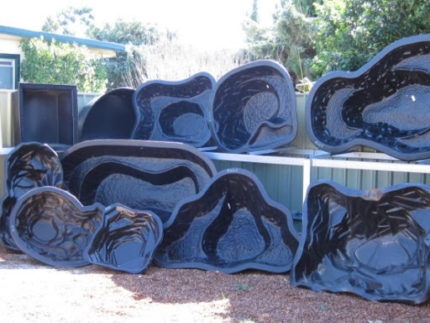
After completion of construction work, you need to wait for the final shrinkage of the soil, and then begin decorating it. For example, a water supply pipe can be disguised using a clay jug.
Option No. 3 - budget film base
The popularity of film as a basis for a pond is due to its budget cost and ease of use. Using film, you can build a water feature of any size and shape.
Manufacturers offer several material options: butyl rubber, PVC, polymer. Their main difference is the permissible service life. Polymer film will last up to 10 years, while rubber film will retain its properties even after 50 years even in conditions of sudden climate change.
The required film size is calculated as follows:
- the maximum width, length and depth of the reservoir are determined;
- two depths are added to the length and an additional 60 cm for the blind area and access to the coastline;
- two depths are added to the width and an additional 20-30 cm on each side for the coastline.
Following the step-by-step instructions for making a film-based pond will guarantee a long service life and reliability of the structure even in winter.
Technology for creating a film bowl:
- First of all, a pit of the desired shape is dug out.It is recommended to design the pond in such a way that the inclination level is 45 degrees and the depth is at least 60 cm. Otherwise, if the temperature drops significantly, the pond may freeze.
- A ditch 15-20 cm wide is dug along the perimeter of the pit. It is necessary for further fixation of the film.
- After this, the bottom is cleared of roots and debris. To level the base, you can use wet sand or geotextile fabric. This will protect the film from possible damage.
- At the next stage, the pit is covered with film. It fits freely, without tension. The edges around the perimeter are fixed with stones or bricks.
- After completing the work, you can fill the pond with water. It is recommended to supply water without pressure. The reservoir should remain in this state for at least a day. During this time, the film will take the desired shape.
- The final stage is trimming excess material. A margin of 20-25 cm should be left under the blind area.
If you plan to populate the pond with fish, then it is better to give preference to a film of light shades: beige or blue. Thanks to this, visibility under water will be better.
Dark or brown colors of the material will create the illusion of a natural pond.
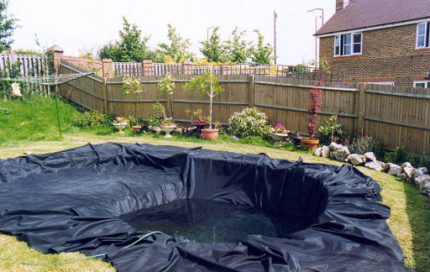
Small pebbles or smooth natural stone laid on the bottom of the reservoir will protect the film from mechanical damage and allow plants to be planted.
It is worth noting that this method will require systematic cleaning of the reservoir. The blind area can be decorated with stones or greenery, having previously been reinforced with concrete mortar.
Option No. 4 - a pond made from scrap materials
You can organize a small pond on your own site even without purchasing special containers. Instead, you can use a bathroom left over after renovation, an unnecessary tire or a tin barrel.

Similarly, any of these items is immersed in a prepared pit, waterproofing work is carried out and water is supplied. The high strength of the rubber will ensure a long service life of the reservoir.
Pond care and water filtration
Large ponds must be equipped with a water filtration system. This point is especially important if you plan to introduce fish into the pond or plant aquatic plants. A ready-made kit can be purchased at a specialized store. Manufacturers include instructions describing the rules for installing and servicing the mechanisms.
For a small pond, you can use a homemade filtration system. To do this, you need to purchase a pump with a sand filter and two pipes: one to drain contaminated water, the other to supply clean water.
Systematic cleaning should be carried out at least once a season:
- In summer, vegetation should be thinned and the water level should be replenished if it decreases due to evaporation. It is important not to supply too cold water, otherwise the animals in the pond may die due to a sharp temperature change.
- In autumn, it is recommended to cover the pond with a special net, sold in stores. It will protect the reservoir from leaf fall and the associated process of rotting in the water. Underwater pruners can be used to periodically remove wilted plants.Before freezing, all electrical appliances must be removed from the water.
- If the pond is large and does not have a concrete base, its inhabitants can safely be left there for the winter. It is important to clean the reservoir from debris and fallen leaves in a timely manner. It is recommended to leave reservoirs with a concrete base without water for the winter, as frosts can cause deformation of the base.
- In spring it is necessary to replace some of the water in the pond. During this time, the fish should be placed in a separate tank.
Regular cleaning is an integral part of maintaining an artificial pond. Avoid using sharp rakes or forks. They can damage the waterproofing.
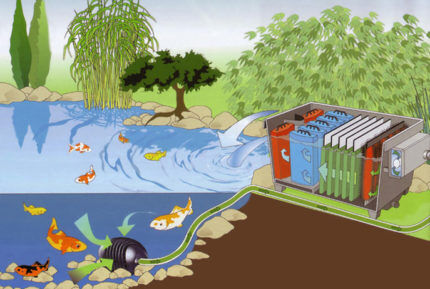
It is recommended to carry out the water purification procedure in an artificial reservoir at least 2 times a year.
Depending on the components used, the following types of cleaning are distinguished:
- Mechanical. It consists of trimming fading plants with pruners and scissors, collecting debris with a net and installing additional filters.
- Chemical. It involves adding special components to water. They normalize acidity, neutralize harmful metals and ammonia, and saturate with oxygen.
- Ultraviolet lamps. With their help, water is disinfected, killing viruses and bacteria.
- Peat or charcoal. They help fight flowering and improve the water quality in the reservoir.
Any artificial reservoir needs periodic water replacement. A complete change of water is harmful to the inhabitants of the pond. It is recommended to update up to 15% of water in one procedure.
Once every 2-3 years, the water must be completely drained to fully clean the reservoir bowl.By following the care requirements, the pond will delight you with cleanliness, lush vegetation and healthy inhabitants for many years.
Decorating your own pond
After completing all construction and preparatory work, you can begin decorating the reservoir. Plants can be planted and fish introduced only after the filtration station has been launched.
The artificial pond will become the main decorative object of the garden area. In addition to living plants, you can create compositions from figurines, natural stones, and small shrubs. You can also place stones at the bottom of the reservoir. It is important that they have a round shape without sharp corners.

You can organize small flower beds around the perimeter of the pond, planting broad-leaved green plants in them. At the stage of digging a pit for a pond, you can lay wiring to organize lighting.
The balance of microflora in the reservoir will depend on the correct selection of aquatic plants. Below are recommendations for selection:
- Arrowhead and ephedra are suitable for planting at shallow depths;
- It is recommended to plant ferns, reeds, reeds, and sedges along the perimeter of the pond;
- floating plants will protect the fish from the scorching sun. Lilies, lotus, water lilies or water hyacinths are suitable for these purposes;
- if you plan to plant flowering plants, pay attention to water iris, lungwort, bergenia and weeping grass.
It is better to plant low-growing and large-leaved plants near decorative ponds. They will not hide the central landscape element.
Preparing the reservoir for wintering
Before preserving the pond in winter, it is necessary to turn off and remove all electrical devices, pumps, filters and lamps.
All vegetation and living creatures should be removed from small bodies of water that completely freeze at sub-zero temperatures. They can be placed in separate tanks for the winter.
You can protect plastic ponds from deformation of the base by placing several bottles filled with sand on the bottom. The quantity is taken at the rate of 1 unit per 1 m2. After the night temperature rises above zero, you can start the pond again.
Conclusions and useful video on the topic
A small pond with a banner base, decorated with natural cobblestones:
Helpful tips on how to prepare a pond with a plastic base for winter:
Creating a pond with your own hands is not difficult. The process does not require large capital investments. All you need is your imagination and free time. By following the technology and step-by-step instructions for decorating a pond, you can radically transform your backyard area.
And by placing sun loungers or a barbecue area near your own pond, you will get a favorite place for the whole family to relax.
If you have questions about the topic of the article or can supplement our material with valuable information regarding the creation of a pond on the site, leave your comments in the communication block, which is located immediately below the article.
